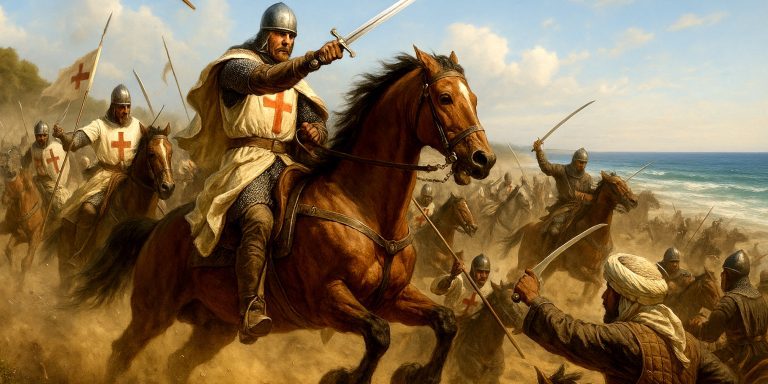
The Battle of Philippi in 42 BC was the decisive clash between the forces of the Second Triumvirate and the assassins of Julius Caesar. Fought in Macedonia, it settled the fate of the Roman Republic and opened the path for Octavian, later Augustus, to establish imperial rule.
The conflict came in two engagements fought in October. On one side stood Mark Antony and the young Octavian, determined to avenge Caesar. On the other were Marcus Junius Brutus and Gaius Cassius Longinus, whose hopes of restoring the Republic hinged on defeating their rivals.
Forces
The size of the armies reflects the scale of the confrontation. Both sides brought some of the largest Republican-era forces ever assembled in the East.
| Side | Commanders | Troop Estimates | Key Notes |
|---|---|---|---|
| Second Triumvirate (Caesarians) | Mark Antony, Octavian | c. 19 legions (approx. 100,000 men), 13,000 cavalry | Veteran soldiers, many loyal to Caesar’s memory |
| Liberators (Republicans) | Brutus, Cassius | c. 17 legions (approx. 90,000 men), 20,000 cavalry | Strong cavalry presence, well-fortified camp |
Leaders and Troop Composition
Caesarian Forces
- Mark Antony: overall field commander, seasoned general with experience from Gaul and the Civil Wars.
- Octavian: nominal co-commander but physically unwell; Antony took the lead in strategy and command.
- Troops:
- 19 legions, many veterans from Caesar’s campaigns
- Cavalry drawn from allied kings and Roman auxiliaries
Republican Forces
- Brutus: intellectual and respected figure, but less experienced in war.
- Cassius: more militarily competent, commander at Carrhae against Parthians.
- Troops:
- 17 legions, some less experienced
- Superior cavalry, including Thracian and eastern contingents
Arms and Armour
Roman legions on both sides were similarly equipped, reflecting the standardised military system of the late Republic.
- Infantry:
- Gladius Hispaniensis (short stabbing sword)
- Pilum (heavy javelin)
- Scutum (large curved shield)
- Lorica hamata (chainmail) or lorica squamata (scale armour)
- Montefortino or Coolus type helmets
- Cavalry:
- Spatha (longer sword for mounted combat)
- Spears and javelins
- Oval shields
- Artillery:
- Ballistae and scorpiones (torsion bolt-throwers) deployed in camps and on the battlefield
Archaeology
The battlefield near modern-day Philippi in northern Greece has been surveyed and partially excavated.
- Traces of Roman camps have been identified on the plain.
- Roman coins, weapon fragments, and sling bullets provide evidence of the conflict.
- The Via Egnatia, the great Roman road, runs through the area and was a key logistical artery for both armies.
The site later became a Roman colony settled by veterans of the battle, confirming its enduring importance.
Battle Timeline
Early October 42 BC – The armies confront each other on the plains near Philippi. Brutus and Cassius fortify strong defensive camps linked to the Via Egnatia.
First Battle (3 October 42 BC)
- Antony launches an assault on Cassius’ position, breaching his fortifications.
- Cassius, mistakenly believing Brutus has been defeated, commits suicide.
- Brutus manages to push back Octavian’s forces, but Antony’s success outweighs the Republican gains.
Second Battle (23 October 42 BC)
- Brutus engages in a direct confrontation with Antony and Octavian.
- Antony’s veterans overpower Brutus’ less experienced legions.
- Brutus flees but commits suicide soon after, ending organised resistance.
Contemporary Quotes
Appian, describing Brutus’ last words to his companions:
“Forget not, Virtue, that I revered thee, though I failed fortune.”
Plutarch records Cassius’ despair after misjudging the outcome of the first battle:
“My very friends have failed me, and fortune has deceived me.”
Outcome
- Decisive victory for Antony and Octavian.
- Deaths of Brutus and Cassius removed the last serious resistance to the Triumvirate.
- Veterans were settled in Philippi, reinforcing Roman control of Macedonia.
- Antony emerged as the immediate military leader, though Octavian would ultimately gain supreme power.
Legacy
The Battle of Philippi ended the hopes of the Republican cause. The deaths of Brutus and Cassius were not only military defeats but also symbolic ones, extinguishing the idea of restoring the Republic.
In the short term, Antony commanded the loyalty of much of the army, but Octavian used his political skill to take control of the West. Within a decade, the rivalry between Antony and Octavian culminated in the Battle of Actium, leaving Octavian sole ruler of Rome.
Philippi therefore stands as a pivotal moment in the transformation of Rome from Republic to Empire.
Watch the documentary:



